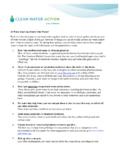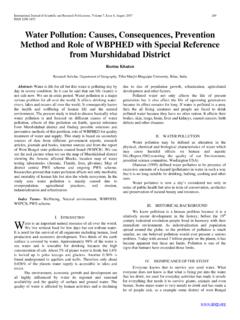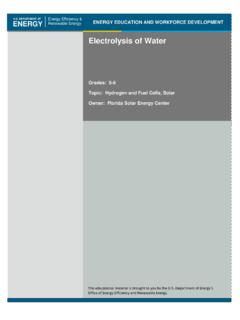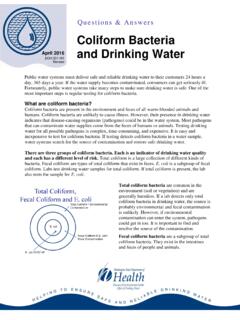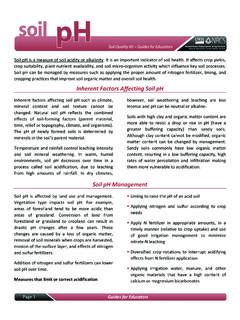Transcription of **SAMPLE** STORM WATER POLLUTION PREVENTION PLAN …
1 Page 1 of 29 FACILITY NAME: Ryan s Marina **SAMPLE** STORM WATER POLLUTION PREVENTION PLAN (SWPPP) Department of Environmental Quality (DEQ) WATER Resources Division (WRD) STORM WATER POLLUTION PREVENTION Plan (SWPPP) Template Sample SWPPP Revision Date: 4/8/2015 Page 2 of 29 TABLE OF CONTENTS General Facility Information STORM WATER POLLUTION PREVENTION Team Site Map Significant Materials Inventory of Exposed Significant Materials Description of Industrial Activities & Significant Material Storage Areas List of Significant Spills Summary of Sampling Data Actions Taken to Investigate Illicit Connections Non-Structural Controls Preventative Maintenance Program Housekeeping Procedures Comprehensive Site Inspection & Visual Assessments of STORM WATER Discharges Material Handling & Spill PREVENTION / Clean-Up Procedures Soil Erosion & Sedimentation Control Measures Employee Training Program TMDL Requirements List of Significant Materials Still Present Structural
2 Controls Non- STORM WATER Discharges Annual Review Industrial STORM WATER Certified Operator Update Record Keeping SWPPP Certification Figure 1 Facility Site Map Table 1 Significant Material Inventory and Description of Industrial Activity or Significant Material Storage Areas Visual Assessment Procedures Table 2 Spill Kit Inventory Routine Inspection Form Comprehensive Site Inspection Form Visual Assessment Report Form Employee Training Form Annual SWPPP Review Report Form DEQ Spill or Release Report Page 3 of 29 GENERAL FACILITY INFORMATION Facility Information: Name of Facility: Ryan s Marina Facility Address: 123 Ryan Way, Muskegon, MI 49999 County: Muskegon Standard Industrial Classification (SIC) Code: 4493 Owner or Authorized Representative: Ryan Grant Facility Contact Information: Name: Ryan Grant Title: Owner Telephone: 616-250-6134 Email Address: Mailing Address: Same as facility address Facility Contact information to be aware of: The Facility Contact was specified in the application.
3 The permittee may replace the facility contact at any time, and shall notify the Department in writing within 10 days after replacement (including the name, address, email address, if available, and telephone number of the new facility contact). a) The facility contact shall be (or a duly authorized representative of this person): for a corporation, a principal executive officer of at least the level of vice president, or a designated representative, if the representative is responsible for the overall operation of the facility from which the discharge described in the permit application or other NPDES form originates, for a partnership, a general partner, for a sole proprietorship, the proprietor, or for a municipal, state, or other public facility, either a principal executive officer, the mayor, village president, city or village manager, or other duly authorized employee.
4 B) A person is a duly authorized representative only if: the authorization is made in writing to the Department by a person described in paragraph a. of this section; and the authorization specifies either an individual or a position having responsibility for the overall operation of the regulated facility or activity such as the position of plant manager, operator of a well or a well field, superintendent, position of equivalent responsibility, or an individual or position having overall responsibility for environmental matters for the facility (a duly authorized representative may thus be either a named individual or any individual occupying a named position). Certified STORM WATER Operator Information: Name: Ryan Grant Certification Number & Expiration Date: i-06490, July 1, 2019 Telephone: 616-250-6134 Email Address: Is the Certified Operator an employee at the facility: Yes No o If the answer to the above question is No then include the Certified Operator s business name and mailing address: NA Permit Information: General Permit Number: MIS310000 Certificate of Coverage (COC) or Individual Permit Number: MIS311111 COC or Individual Permit Effective Date of Coverage: 6/19/2012 Receiving Waters: Muskegon Lake Required Monitoring: Yes No Identify the Total Daily Maximum Load (TMDL) listed on COC.
5 Phosphorus Brief Industrial Activity Description: Full service marina. Page 4 of 29 If this facility is a seasonal facility describe the seasonal operation and what months the facility will be operating: The full service marina operates April through November annually. The marina is shut down and has very limited staff December through the end of March. STORM WATER POLLUTION PREVENTION TEAM The STORM WATER POLLUTION PREVENTION team is responsible for developing, implementing, maintaining, and revising this SWPPP. The members of the team and their primary responsibilities ( implementing, maintaining, record keeping, submitting reports, conducting inspections, employee training, conducting the annual compliance evaluation, testing for non- STORM WATER discharges, signing the required certifications) are as follows: Name & Title Responsibility Ryan Grant SWPPP implementation Mike Worm, Maintenance Supervisor Back up STORM WATER program contact Space to list additional members and their responsibility if necessary: NA SITE MAP Preparing a site map or sketch is the first step in assessing the facility.
6 See the DEQ Industrial STORM WATER Certified Operator Training Manual for additional information. The facility s site map includes all applicable items listed in the permit, which include: 1) Buildings and other permanent structures 2) Storage or disposal areas for significant materials 3) Secondary containment structures and descriptions of what they contain in the primary containment structures 4) STORM WATER discharge points (which include outfalls and points of discharge), numbered or otherwise labeled for reference 5) Location of STORM WATER and non- STORM WATER inlets (numbered or otherwise labeled for reference) contributing to each discharge point 6) Location of NPDES permitted discharges other than STORM WATER 7) Outlines of the drainage areas contributing to each discharge point 8) Structural runoff controls or STORM WATER treatment facilities 9)
7 Areas of vegetation (with brief description such as lawn, old field, marsh, wooded, etc.) 10) Areas of exposed and/or erodible soils and gravel lots 11) Impervious surfaces (roofs, asphalt, concrete, etc.) 12) Name and location of receiving waters 13) Areas of known or suspected impacts on surface waters as designated under Par 201 (Environmental Response) of the NREPA. SEE FIGURE 1 FOR FACILITY SITE MAP SIGNIFICANT MATERIALS Definition: Significant materials are any material which could degrade or impair WATER quality, including but not limited to: Raw Materials Fuels Solvents Page 5 of 29 Detergents Plastic pellets Finished materials ( metallic products) Hazardous Substances designated under section 101(14) of Comprehensive Environmental Response, Compensation, and Liability Act (CERCLA), see 40 CFR Any chemical the facility is required to report pursuant to section 313 of the Emergency Planning and Community Right-to-Know Act (EPCRA) Polluting Materials Oil and any material, in solid or liquid form, identified as polluting material under the Part 5 Rules (Rules through of the Michigan Administrative Code)
8 Hazardous Wastes as defined in Part 111 of the Michigan Act Fertilizers Pesticides Waste Products ( ashes, slag, sludge, plant waste, animal waste) During the significant materials identification phase, all sources of potential STORM WATER contamination need to be identified. Both the inside and outside of the facility must be inventoried to determine the materials and practices that may be sources of contamination to STORM WATER runoff. Note the identification phase must address residual contaminants which may be found on items stored outside. Inventory of Exposed Significant Materials The permit requires a general inventory of significant materials that could enter STORM WATER . For each material listed the SWPPP shall include the ways in which each type of material has been or has reasonable potential to become exposed to STORM WATER ( spillage during handling; leaks from pipes, pumps, or vessels; contact with storage piles, contaminated materials or soils; waste handling and disposal; deposits from dust or overspray; etc.)
9 In addition, the SWPPP must identify the inlet(s) spilled significant materials may enter and the discharge point(s) through which the spilled significant material may be discharged. SEE TABLE 1 FOR SIGNIFICANT MATERIAL INVENTORY Description of Industrial Activities & Significant Material Storage Areas The permit requires industrial facilities to evaluate the reasonable potential for contribution of significant materials to STORM WATER runoff from at least the following areas or activities: 1) Loading, unloading, and other material handling operations 2) Outdoor storage including secondary containment structures 3) Outdoor manufacturing or processing activities 4) Significant dust or particulate generating processes 5) Discharge from vents, stacks, and air emission controls 6) On-site waste disposal practices 7) Maintenance and cleaning of vehicles, machines, and equipment 8) Areas of exposed and/or erodible soils 9) Sites of Environmental Contamination listed under Part 201 (Environmental Response) of the NREPA 10) Areas of significant material residues 11) Areas where animals congregate (wild or domestic) and deposit wastes 12)
10 Other areas where STORM WATER may contact significant materials For each applicable item, the permit requires a written description of the specific activity or storage area. Along with the written description of the activities or storage areas, a description of the significant materials associated with those items must be included. SEE TABLE 1 FOR INDUSTRIAL ACTIVITY AND SIGNIFICANT MATERIAL STORAGE AREA DESCRIPTIONS Page 6 of 29 List of Significant Spills The permit requires a list of significant spills and significant leaks of polluting materials that occurred at areas that are exposed to precipitation or that otherwise discharge to a point source at the facility. The listing shall include spills that occurred over the three years prior to the effective date of a certificate of coverage authorizing discharge under the General Permit.










